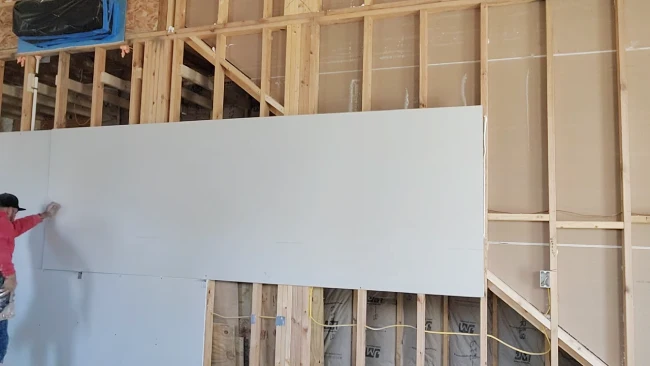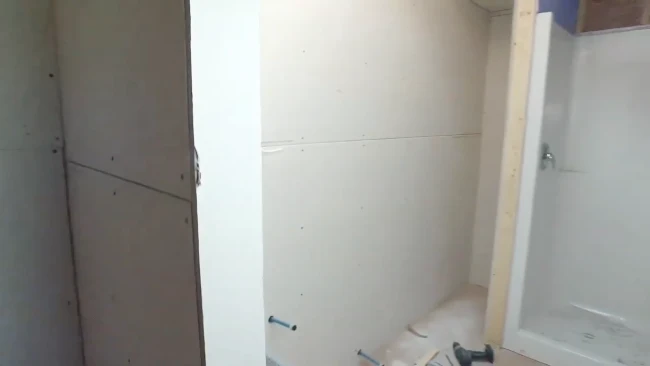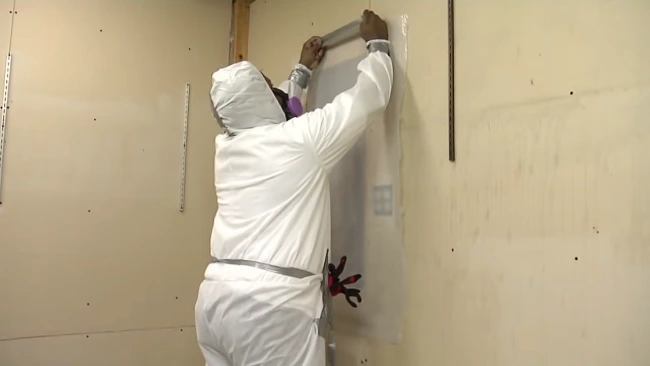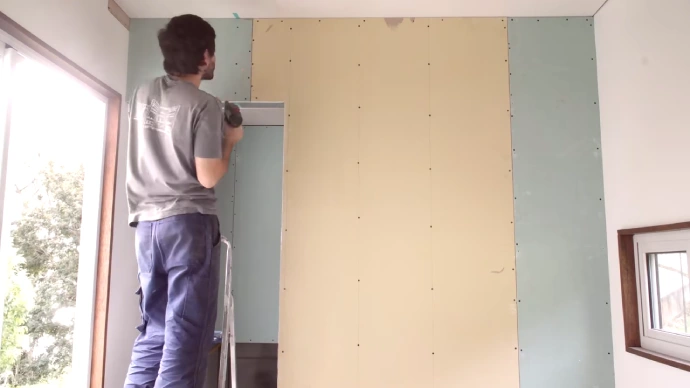Last Updated on July 26, 2023
Sheetrock gypsum board is a common construction material for walls and ceilings. For this reason, there have been concerns about whether it contains asbestos.
In the past, asbestos was used in a variety of construction products, including sheetrock, for its durability, heat resistance, and insulation properties.
But, research has shown that exposure to asbestos fibers can lead to serious lung diseases, such as mesothelioma and asbestosis, which can be fatal. As such, many countries have heavily regulated and restricted the use of asbestos in building materials, including sheetrock.
Since the late 1970s, manufacturers have taken steps to replace asbestos with alternative materials in their sheetrock products.
As a result, modern sheetrock is asbestos-free so long as it was manufactured after this time period. Let’s talk about how to tell if your sheetrock drywall has asbestos and what to do if it does. Keep reading to stay in the know.
How Do You Know Whether There Is Asbestos in Your Home’s Sheetrock Drywall or Not?

If you need clarification on whether there’s asbestos present in your home’s sheetrock and drywall, there are a few things to consider. The following is a brief overview:
2. Consult an Asbestos Professional
3. Hire an Accredited Laboratory
Let’s discuss this in more detail.
1. Age of the Building
Consider the age of your building when assessing the potential presence of asbestos-containing materials.
Asbestos was commonly used in construction materials until the 1980s. It is more likely that asbestos-containing materials were used in constructing your home if it was built before that time.
This includes sheetrock drywall, which may contain asbestos fibers within the joint compound or texture coating.
But, it is worthy of note that not all older buildings necessarily have asbestos-containing materials. Throughout the 1970s and 1980s, the use of asbestos declined significantly.
Therefore, if your home was built towards the end of this timeframe or after it, you may be less likely to encounter asbestos in your sheetrock drywall.
2. Consult an Asbestos Professional
To ensure the safety of your home, it is highly recommended that you consult with a licensed asbestos professional. They have the expertise and equipment to test for and remove any potential asbestos-containing materials properly.
When consulting with an asbestos professional, they’ll thoroughly inspect your property to identify any potential sources of asbestos. They’ll then collect samples for testing in a certified laboratory. If asbestos is found, they’ll develop a safe removal or encapsulation plan to prevent further exposure.
You should never attempt removal yourself, as it can release dangerous fibers into the air and put you and your family at risk.
3. Hire an Accredited Laboratory
You can also hire an accredited laboratory to test any potential asbestos-containing materials in your home properly. An accredited laboratory will have the necessary equipment and expertise to identify whether sheetrock contains asbestos accurately.
When contacting an accredited laboratory, they’ll provide instructions on collecting and sending samples for analysis. You need to follow these instructions carefully to ensure accurate results.
To ensure safety, please wear protective gear when collecting small samples of suspected drywall material for analysis. This precaution is necessary to determine the presence or absence of hazardous asbestos and to protect both yourself and others.
To collect a sample, use a utility knife or scraper to cut a small piece of the drywall without causing damage or releasing fibers into the air.
Place the sample in a sealed container or bag and send it to an accredited laboratory for testing. The laboratory will conduct specific tests to determine if asbestos is present.
Once the samples are analyzed, the laboratory will provide a report detailing their findings. If asbestos is present, they can also advise you on proper removal procedures to ensure the safety of everyone involved.
Is living in a house with a gypsum board containing asbestos safe?

You don’t want to imagine the potential health risks of living in a house with a gypsum board that contains asbestos fibers.
Prolonged exposure to these fibers can cause lung diseases, including lung cancer, mesothelioma, and asbestosis. Asbestos is a known carcinogen and poses a significant danger to occupants if not handled properly. So it’s better to address the issue promptly and ensure a safe living environment.
What should you do if your house contains asbestos-containing gypsum board?
As soon as you realize your house contains an asbestos-containing gypsum board, seek professional assistance to ensure your safety.
It is essential not to disturb or damage asbestos-containing materials. You should consult with a professional who specializes in removing and remediating asbestos.
They can assess the situation and conduct proper testing to confirm asbestos presence. Once confirmed, they’ll develop a safe and effective plan for its removal or encapsulation.
Attempting asbestos removal on your own is not a good idea, as improper handling can lead to greater health risks.
It is also advisable to minimize direct contact with areas suspected to contain asbestos and temporarily relocate until the issue is resolved.
What are the common symptoms or health effects of asbestos exposure from drywall?

When you inhale asbestos fibers, they can cause serious respiratory problems such as coughing, wheezing, and shortness of breath. You may also experience chest tightness, pain, and persistent coughing that doesn’t go away.
Unfortunately, prolonged asbestos exposure can lead to more severe conditions. Like asbestosis, a chronic lung disease that scars your lungs. Also, mesothelioma is a rare but aggressive form of cancer that affects the lungs, abdomen, or heart lining.
You must note that these symptoms and health effects may not appear immediately after exposure but can take years or even decades to manifest themselves.
If you suspect any potential asbestos exposure from drywall or other sources, seek medical attention promptly and inform your healthcare provider about the situation. Early detection is crucial for managing any related health conditions.
Create a Healthier Home with Asbestos-Free Sheetrock
Asbestos was commonly used in building materials until the 1980s. So if your home was built before, your sheetrock could contain asbestos.
Living in a house with asbestos-containing gypsum board is not necessarily unsafe as long as the material remains intact and undisturbed.
If you plan on renovating or making any changes to your walls, be sure to have the material tested for asbestos. Also, take proper safety precautions if it does contain this hazardous material.
Symptoms of asbestos exposure from drywall can include shortness of breath, coughing, chest pain, and lung cancer.
If you suspect you have been exposed to asbestos from drywall or other building materials containing this substance, seek medical attention immediately.



